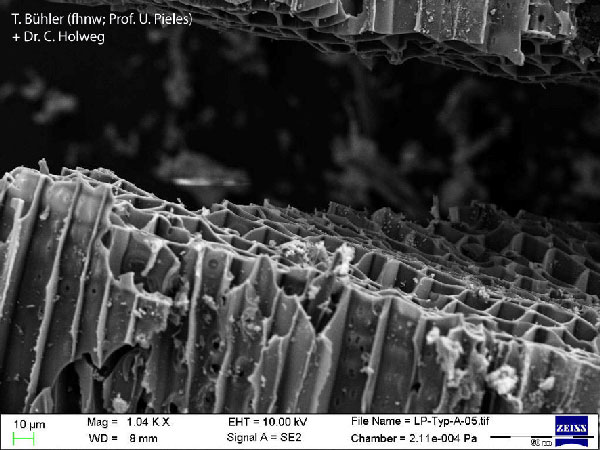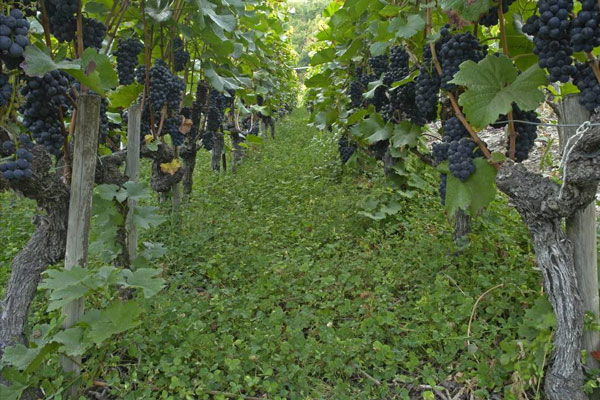19.11.2010
Die besonderen Potenziale von Terra Preta
Blühende LandschaftenDie Indios nutzten schon vor 7.000 Jahren die Fruchtbarkeit von Schwarzerde. Terra Preta kann beim Kampf gegen Welthunger und Klimakrise helfen. Ein Besuch bei den Pionieren. VON UTE SCHEUB
Schwarzerde wurde im Amazonasgebiet schon lange vor der Kolonialzeit eingesetzt. Foto: imago/photoshot/evolve
Und plötzlich Schwärme von Schmetterlingen. Vor dem Hintergrund blauer Viertausender flattert und flirrt es in allen Farben und Formen. Bläulinge, weißbunte Schwalbenschwänze, Kleine Wiesenvögelchen und Scheckenfalter lutschen an Luzernen, die neben Weinstöcken wuchern.
Nur wenige Schritte weiter, zwischen den konventionell bewirtschafteten Reben des Nachbarn, wirkt alles steril - Monokultur im Schweizer Wallis. Wie militärisch aufgereiht stehen: Reben, Reben, Reben. "Vor fünf Jahren, als wir den Weinberg übernahmen, hatten wir auch fast toten Boden", lacht Hans-Peter Schmidt, Leiter des Forschungsweinguts Mythopia. Hier darf sich die Vielfalt der Natur frei entfalte(r)n - die Schmetterlinge sind Indikatoren der Pflanzendiversität.
Mythopia, das ist ein Wortspiel aus Mythos und Utopie. Hans-Peter Schmidt, studierter Philosoph, hager und braun gebrannt, liebt solche Anspielungen. Ithaka, so hat er das von ihm betreute Internetjournal von Mythopia genannt. Die meisten Bewohner von Odysseus Heimatinsel sind mangels Lebensgrundlagen ausgewandert.
"Ithaka steht für die Sehnsucht der von der Landwirtschaft vertriebenen Schmetterlinge, Bienen, Libellen, Gottesanbeter, in absehbarer Zukunft wieder ihre angestammten Lebensräume in den Weinbergen, Wiesen und Feldern zu bewohnen", heißt es auf www.ithaka-journal.net.
Terra Preta
Geschichte: Terra Preta do Indio, zu Deutsch Indianerschwarzerde, hat in den Gartenstädten des vorkolonialen Amazonasgebiets Millionen Menschen ernährt und den nährstoffarmen Regenwaldboden in einen der fruchtbarsten Böden der Welt verwandelt.
Bestandteile: In den 1990er Jahren fanden Forscher heraus, dass die bis zu 7.000 Jahre alten und etwa zwei Meter dicken Schwarzerdeschichten aus organischen Abfällen, Holzkohle, tierischen und menschlichen Exkrementen, Knochen und Tonscherben bestehen. Offenbar ließen die Indios ihre Siedlungsabfälle in Tongefäßen unter Luftabschluss einige Monate fermentieren, nahmen danach die Deckel ab und pflanzten Obstbäume und Gemüse in die so entstandene Schwarzerde. Das Wissen um deren Produktion ging jedoch mit der Ausrottung der Ureinwohner durch die Spanier verloren.
Technik: 2005 wurde die Herstellung experimentell wiederentdeckt. Der Aufwand ist gering. Die Milchsäurefermentierung wird durch gepresste organische Abfälle in luftdichten Behältern in Gang gesetzt - eine Technik, die seit Jahrtausenden zur Nahrungskonservierung genutzt wird, etwa bei Sauerkraut. Gibt man Holzkohlenstaub hinzu, siedeln sich in der porösen Kohle komplexe Lebensgemeinschaften von Mikroorganismen an. Zudem bindet die Kohle Schadstoffe, unterdrückt Fäulnis und Krankheitserreger.
Ernteerfolge: Dank ihrer stabilen Struktur baut sich Humus in Terra-Preta-Böden nicht ab, Biokohle speichert wie ein Akku Energie, Nährstoffe, Wasser und Luft in Bodenleben. Nutzpflanzen ernähren sich bedarfsgerecht, im Vergleich zu kunstdüngerversorgten Pflanzen sind sie größer, resistenter und ertragreicher. Oft verdoppeln bis verachtfachen sich die Ernten. Selbst ausgelaugte oder trockene Böden können wieder bewirtschaftet werden, wie erste Versuche in der Sahara belegen.
Infos: www.palaterra.eu, www.triaterra.de
****************
Pioniere weltweit
Traditionen: Manche Schwarzerden sind menschengemacht, manche natürlich entstanden. Der japanische Dünger "haigoe" wurde aus Siedlungsabfällen plus Holzkohle aus Reisspelzen produziert. Im afrikanischen Benin wird Schwarzerde traditionellerweise von Frauen hergestellt; bisher ist es niemandem gelungen, die Geheimrezeptur zu erfahren.
Neue Techniken: Die neue "schwarze Revolution" geht vom deutschsprachigen Raum aus. Die Ökoregion Kaindorf, ein Zusammenschluss von sechs Gemeinden, will bis 2020 kohlendioxidneutral werden. Ein Teilprojekt ist der Humusaufbau mittels Terra Preta. Im Winter soll dort die erste Pyreganlage Österreichs zur Verkohlung von Knochen und Papierfaserschlamm in Betrieb gehen.
Vorreiter: Im Chiemgau experimentieren Landwirte um Christoph Fischer mit Biokohle. Im nördlichen Brandenburg stellt Marco Heckel auf seinem Hof Terra-Preta-Zutaten her, zu beziehen unter www.triaterra.de. Terra-Preta-Versuche gibt es auch in Algerien, auf den Philippinen, in Ghana und weiteren Ländern.
Diesen Bericht über Terra Preta und viele andere Texte mehr lesen Sie in der sonntaz vom 20./21. November 2010. Diese sonntaz-Ausgabe enthält einen Schwerpunkt zum regionalen Wirtschaften mit Erfolgsmodellen von Energie bis Ernährung. Die sonntaz kommt jetzt auch zu Ihnen nach Hause: per Wochenendabo. Foto: taz
Auch der gebürtige Sachse Schmidt sieht sich im französischsprachigen Wallis als Wanderer zwischen den Welten, als Vagabund, der sein Herz nicht an Reichtümer hängt, sondern an die Natur. In Mythopia duftet es nach Thymian und Salbei, Curry und Lavendel. Zwischen den Reben stehen Wildkräuter, Rosen und Ringelblumen, alte Getreidesorten, Tomaten, Kürbisse und Gemüse aller Art.
Obstbäume für Insekten und Menschen
Um Inseln für nützliche Insekten, Bakterien und Pilze zu schaffen, ließ Schmidt mindestens alle 50 Meter einen Obstbaum pflanzen: Apfel, Quitte, Pfirsich, Kirsche, Aprikose, Mandel oder Feige. Kästen mit Schlupflöchern dienen als "Wildbienenhotels", auch Schlupfwespen wohnen hier und verspeisen die Plage der benachbarten Monokultur.
Hier und da kleben Wissenschaftler wie große Insekten im Weinberg. Der Biologe Claudio Niggli freut sich: Er hat insgesamt 47 tagaktive Schmetterlingsarten und über 150 verschiedene Wildpflanzen gezählt. Die rasant gestiegene Biodiversität ist indes nur eine der Besonderheiten der Domaine de Mythopia, die andere ist das "Klimafarming" mit Terra Preta.
Auf 3.000 Quadratmetern findet hier der erste und bisher größte Feldversuch in Europa statt. Der US-Bodenwissenschaftler Andrew Crane-Droesch von der Universität Berkeley, der gerade die Wasserspeicherkapazität der Erde misst, ist begeistert: Anders als auf den Nachbargrundstücken, wo in den heißen Sommern des Wallis ständig Sprenkler laufen, muss in Mythopia kaum gewässert werden, weil die Biokohle Feuchtigkeit speichert. Auch sind die Weinstöcke auf der Schwarzerde größer und ertragreicher als vergleichbare Bio- oder konventionelle Reben.
Humusaufbau durch Schwarzerde
Schwarzerde ist nicht nur gut für Schmetterlinge, sondern für alle Lebewesen, weil sie Dauerhumus bildet. Derzeit wird durch Raubbau, Klimakrise und Agroindustrie weltweit 6.000-mal so viel Humus ab- wie aufgebaut.
Nach UN-Zahlen ist in den letzten 20 Jahren fast ein Viertel der globalen Landfläche degradiert; rund 1,5 Milliarden Kleinbauern ernten immer weniger, vor allem in Afrika. Humuswirtschaft mittels selbst erzeugter Schwarzerde würde sie unabhängig machen von Kunstdünger und Agrokonzernen und ihnen damit ein wirksames Mittel gegen den Hunger an die Hand geben.
Bruno Glaser von der Universität Bayreuth ist überzeugt, Terra Preta könne "aus eigentlich unfruchtbaren Böden blühende Landschaften" machen. Auch Haiko Pieplow vom Bundesumweltministerium sieht darin eine "Jahrhundertinnovation".
Schmidt ließ sich vor fünf Jahren samt Familie auf der Domaine de Mythopia nieder und produziert seither Bioweine für den Versandhandel Delinat. Dessen Inhaber Karl Schefer hat eine Stiftung gegründet, die das seit Juni 2009 im Wallis ansässige Delinat-Institut für Ökologie und Klimafarming finanziert.
Unter Schmidts Leitung betreiben zehn Mitarbeiter Feldforschung, arbeiten über das Netzwerk Biokohle mit diversen Universitäten zusammen und veröffentlichen alle Ergebnisse auf der Website www.delinat-institut.org.
In diesem Jahr hat das Institut 500 Kleinbauern und Hobbygärtnerinnen eingeladen, sich an Versuchen mit Biokohle zu beteiligen; auch deren Ergebnisse werden ins Internet gestellt. "500 überzeugte Kleingärtner erzählen das je 25 Leuten weiter, deshalb wird sich die Idee rasant durchsetzen", glaubt Hans-Peter Schmidt. "Wir haben einen Traum, ein Ziel", schreibt er im Ithaka-Journal. "Wenn es gelingt, werden bis 2020 - zumindest in der Schweiz - die meisten Landwirte Klimafarming betreiben."
Seit zweieinhalb Jahren wird in Mythopia Schwarzerde in 25 Meter langen Rotten auf einer Talwiese aus Kompost und Biokohle innerhalb von sechs Wochen hergestellt. Die Kohle dafür liefert seit Anfang 2010 eine "Pyreg"-Pyrolyseanlage von Swiss Biochar in Lausanne. Sie optimiert die Klimafreundlichkeit der Biokohle, aber rein technisch ist sie nicht nötig.
In Mythopia geht es um die Freiheit aller Lebewesen. Unabhängig sollen auch die 90 Suchtabhängigen werden, die weiter bergauf unter Anleitung des Delinat-Instituts seit Anfang des Jahres Gemüse auf Terra-Preta-Böden züchten. Ihr Leiter Philippe Mottet ist zuversichtlich, dass die gärtnerischen Erfahrungen ihnen zur Gesundung verhelfen. Erste Erfolge seien schon sichtbar, eine magersüchtige Frau etwa habe ihre Tochter wieder annehmen können.
Revolutionäre in einem pfälzischen Weiler
Schmetterlinge sind freie Gesellen, sie wechseln oft den Ort, und wir ziehen mit ihnen weiter. Dort, wo die westdeutsche Pfalz am ländlichsten ist und am wenigsten Arbeit und Zukunftsperspektiven bietet, liegt inmitten von weichen Hügeln der Weiler Hengstbacherhof. Auf den sieben Bauernhöfen leben 30 Bewohner, es gibt Hühner, Enten und Gemüsebeete, ein Bauerncafé, einen Teich und ein Indianerzeltdorf mit wehender schwarzer St.-Pauli-Fahne.
Hier wohnt der quirlige Joachim Böttcher, gebürtiger Hesse, Antiatom- und Startbahn-West-Kämpfer und nun Schwarzerde-Pionier. Der Oberrevolutionär von 1848, Friedrich Hecker, habe sich in Hengstbacherhof versteckt, erzählt er stolz, auch der Schinderhannes, der "Robin Hood vom Hunsrück", sei hier gewesen. Das Bauerncafé trägt seinen Namen.
Das Gut ernährt seine Leute im Überfluss. Im Gemüsegarten, seit 2008 voller Terra-Preta-Erde, "wächst alles viel zu schnell", sagt der gelernte Gärtner Böttcher. Auch hier flattern Falter, mangels Luzernen aber nicht so viele wie im Wallis.
Das Maggikraut ist 2,50 Meter in die Höhe geschossen, die Radieschen sind groß wie Hühnereier, eine Kartoffelknolle brachte ein ganzes Kilo auf die Waage. Auch im Sommer werden die Pflanzen nicht gegossen und wachsen dennoch schneller als anderswo. "Damit ist die Welternährung gesichert", lacht Joachim Böttcher ein jungenhaftes Lachen.
Schwarzerdeproduktion begann in einer Garage
In einem Schuppen begann er 2005 seine Experimente zur Schwarzerdeproduktion. "Die Bill-Gates-Garage", sagt Böttcher selbstbewusst. Schräg gegenüber leuchtet in der Sonne die nagelneue Anlage für jährlich 500 Kubikmeter Terra Preta, die wie ein größeres Gewächshaus aussieht.
Betreiber mit bislang fünf Beschäftigten ist die Palaterra Vertriebsgesellschaft, die Böttcher zusammen mit der Wind-, Bio- und Solarfirma Juwi gegründet hat. Auch in Hengstbacherhof stellt eine "Pyreg"-Anlage Biokohle her; auf fünf Rotten wird aus Grünschnitt, Biogasanlagen-Abfall, Mist und Chinaschilf in einem mehrwöchigen Prozess Terra Preta.
Die Stoffströme der Anlage sind geschlossen: Gase werden wieder eingeblasen, in einer Pflanzenkläranlage filtert Chinaschilf das Wasser, die entstehende Überschusswärme geht in die Fußbodenheizung. Und wenn alles gut läuft, werden 2011 im nahen Energiepark Morbach und im fernen Schanghai größere Anlagen gebaut. Ein chinesischer Regierungsbeauftragter will Palaterra die Generallizenz für China erteilen, auch etliche europäische Länder sind interessiert.
Lange Jahre hat der umtriebige Böttcher vor allem Pflanzenkläranlagen und Naturschwimmbäder gebaut, die Region ist voll davon. 2005 lernte er den Bodenwissenschaftler Haiko Pieplow und den Mikrobiologen Alfons Krieger kennen, gemeinsam tüftelten sie aus, wie die Indios wohl ihre Schwarzerde hergestellt haben.
Uneinigkeit in der Szene über Patentantrag
Als Proben ergaben, dass die Terra Preta vom Amazonas und die vom Hengstbacherhof weitgehend identisch sind, meldete Böttcher das Verfahren als Patent an - "das ist schließlich auf meinem Mist gewachsen". Ein Schritt, den andere Schwarzerde-Pioniere heftig kritisieren. "Das Patent ist ein Verrat an der Idee", schimpft etwa Hans-Peter Schmidt. Kleingärtner sollten machen, was sie wollen, von denen werde man keine Lizenzgebühren eintreiben, verteidigt sich Joachim Böttcher.
"Aber bei Großanlagen wollen wir ein Wörtchen mitreden." Kommunen sollen beim Stoffstrommanagement begleitet werden, und Böttcher will dafür sorgen, dass das ganze Verfahren nicht durch Trittbrettfahrer oder Hygieneprobleme in Verruf gebracht wird. Die Anerkennung durch das Europäische Patentamt steht aber noch aus, und vielleicht kommt sie auch gar nicht, weil uralte Kulturtechniken nicht patentierbar sind.
Bei einem anderen Thema sind sich Schmidt und Böttcher einig: Auch Biokohle kann missbraucht werden. Im Rahmen des globalen Treibhausgashandels und der derzeitigen massiven Landkäufe in Afrika sei es denkbar, dass Großkonzerne Wälder abholzen und in Form von Holzkohle unter die Erde bringen, um auf diese extrem fragwürdige Weise Kohlendioxid einzusparen.
"Biokohle muss immer in regionale Stoffströme eingebettet werden", fordert Böttcher. Deshalb betreibt er zusammen mit den Bauernaktivisten Michael Diestel und Christoph Fischer die Gründung einer Art Muttergenossenschaft, die ein Gütesiegel für gutes Stoffstrommanagement entwickelt und Terra-Preta-Genossenschaften bei der Gründung hilft. "Wir brauchen noch Leute mit Ideen, auch die taz-Genossen sind herzlich zum Mitmachen eingeladen", sagt er.
Noch in einem weiteren Punkt gleichen sich die Pioniere Schmidt und Böttcher: Sie haben Ausstrahlung, sie haben Visionen, und sie wollen die Unabhängigkeit von der Agroindustrie. Schmetterlings-Schmidt schwärmt von Biodiversität, Chinaschilf-Böttcher von naturnahen Gewässern und Waldstädten. Der Pfälzer hat die konservativen Landwirte von Rockenhausen in einer Zukunftswerkstatt so sehr begeistert, dass deren Gesamtgemeinderat vor etwa einem Jahr mit Zustimmung aller Fraktionen beschloss, bis 2020 Nullemissionsort zu werden.
Die Anzeichen in der Region sind jetzt schon unübersehbar: Wind-, Solar- und Pflanzenkläranlagen allüberall. In St. Alban steht ein "Sonnenpark", in dem Ingenieur Klaus Becher raffiniert gebaute Biosolarhäuser ohne Heizung verkauft. Auf dem Hügel nebenan betreibt Juwi neben einem Solarpark das größte Binnenwindrad Europas. Und auf vielen Höfen glänzen Solardächer. Die strukturschwache Region Pfalz ist drauf und dran, Avantgarde zu werden.
Mit Schmetterlingen im Bauch.
Geschichte: Terra Preta do Indio, zu Deutsch Indianerschwarzerde, hat in den Gartenstädten des vorkolonialen Amazonasgebiets Millionen Menschen ernährt und den nährstoffarmen Regenwaldboden in einen der fruchtbarsten Böden der Welt verwandelt.
Bestandteile: In den 1990er Jahren fanden Forscher heraus, dass die bis zu 7.000 Jahre alten und etwa zwei Meter dicken Schwarzerdeschichten aus organischen Abfällen, Holzkohle, tierischen und menschlichen Exkrementen, Knochen und Tonscherben bestehen. Offenbar ließen die Indios ihre Siedlungsabfälle in Tongefäßen unter Luftabschluss einige Monate fermentieren, nahmen danach die Deckel ab und pflanzten Obstbäume und Gemüse in die so entstandene Schwarzerde. Das Wissen um deren Produktion ging jedoch mit der Ausrottung der Ureinwohner durch die Spanier verloren.
Technik: 2005 wurde die Herstellung experimentell wiederentdeckt. Der Aufwand ist gering. Die Milchsäurefermentierung wird durch gepresste organische Abfälle in luftdichten Behältern in Gang gesetzt - eine Technik, die seit Jahrtausenden zur Nahrungskonservierung genutzt wird, etwa bei Sauerkraut. Gibt man Holzkohlenstaub hinzu, siedeln sich in der porösen Kohle komplexe Lebensgemeinschaften von Mikroorganismen an. Zudem bindet die Kohle Schadstoffe, unterdrückt Fäulnis und Krankheitserreger.
Ernteerfolge: Dank ihrer stabilen Struktur baut sich Humus in Terra-Preta-Böden nicht ab, Biokohle speichert wie ein Akku Energie, Nährstoffe, Wasser und Luft in Bodenleben. Nutzpflanzen ernähren sich bedarfsgerecht, im Vergleich zu kunstdüngerversorgten Pflanzen sind sie größer, resistenter und ertragreicher. Oft verdoppeln bis verachtfachen sich die Ernten. Selbst ausgelaugte oder trockene Böden können wieder bewirtschaftet werden, wie erste Versuche in der Sahara belegen.
Infos: www.palaterra.eu, www.triaterra.de
****************
Pioniere weltweit
Traditionen: Manche Schwarzerden sind menschengemacht, manche natürlich entstanden. Der japanische Dünger "haigoe" wurde aus Siedlungsabfällen plus Holzkohle aus Reisspelzen produziert. Im afrikanischen Benin wird Schwarzerde traditionellerweise von Frauen hergestellt; bisher ist es niemandem gelungen, die Geheimrezeptur zu erfahren.
Neue Techniken: Die neue "schwarze Revolution" geht vom deutschsprachigen Raum aus. Die Ökoregion Kaindorf, ein Zusammenschluss von sechs Gemeinden, will bis 2020 kohlendioxidneutral werden. Ein Teilprojekt ist der Humusaufbau mittels Terra Preta. Im Winter soll dort die erste Pyreganlage Österreichs zur Verkohlung von Knochen und Papierfaserschlamm in Betrieb gehen.
Vorreiter: Im Chiemgau experimentieren Landwirte um Christoph Fischer mit Biokohle. Im nördlichen Brandenburg stellt Marco Heckel auf seinem Hof Terra-Preta-Zutaten her, zu beziehen unter www.triaterra.de. Terra-Preta-Versuche gibt es auch in Algerien, auf den Philippinen, in Ghana und weiteren Ländern.

Diesen Bericht über Terra Preta und viele andere Texte mehr lesen Sie in der sonntaz vom 20./21. November 2010. Diese sonntaz-Ausgabe enthält einen Schwerpunkt zum regionalen Wirtschaften mit Erfolgsmodellen von Energie bis Ernährung. Die sonntaz kommt jetzt auch zu Ihnen nach Hause: per Wochenendabo. Foto: taz

 Die Analyse der ersten Daten zeigt wie erwartet kein einheitliches Bild. Immerhin ist die Anzahl der positiven Ergebnisse (Mehrertrag mit Biokohle > 10%) doppelt so gross wie die der negativen (Minderertrag mit Biokohle > 10%). Biokohle ist nicht einfach ein Dünger, sondern ein langfristig wirksamer Bodenverbesserer. Die Wirkung hängt zudem von vielen Faktoren ab, wie Bodentyp, Bodengeschichte, Bewässerung und Kompostqualität. Zudem reagieren unterschiedliche Pflanzenfamilien unterschiedlich auf Veränderungen im Boden. Kohlgewächse beispielsweise haben eine sehr positive Bilanz gezeigt, Karotten eher negativ auf die Kohle reagiert. Wenn sie an den Details interessiert sind, steht Ihnen unserer Ithaka-Artikel zur Verfügung.
Die Analyse der ersten Daten zeigt wie erwartet kein einheitliches Bild. Immerhin ist die Anzahl der positiven Ergebnisse (Mehrertrag mit Biokohle > 10%) doppelt so gross wie die der negativen (Minderertrag mit Biokohle > 10%). Biokohle ist nicht einfach ein Dünger, sondern ein langfristig wirksamer Bodenverbesserer. Die Wirkung hängt zudem von vielen Faktoren ab, wie Bodentyp, Bodengeschichte, Bewässerung und Kompostqualität. Zudem reagieren unterschiedliche Pflanzenfamilien unterschiedlich auf Veränderungen im Boden. Kohlgewächse beispielsweise haben eine sehr positive Bilanz gezeigt, Karotten eher negativ auf die Kohle reagiert. Wenn sie an den Details interessiert sind, steht Ihnen unserer Ithaka-Artikel zur Verfügung. Autor:
Autor:
 Approximately the same amount is released by plant respiration and decay of dead plant material. The 60 billion tons released from decomposing biomass is almost 10 times more carbon than released by fossil fuel burning.
Approximately the same amount is released by plant respiration and decay of dead plant material. The 60 billion tons released from decomposing biomass is almost 10 times more carbon than released by fossil fuel burning.

